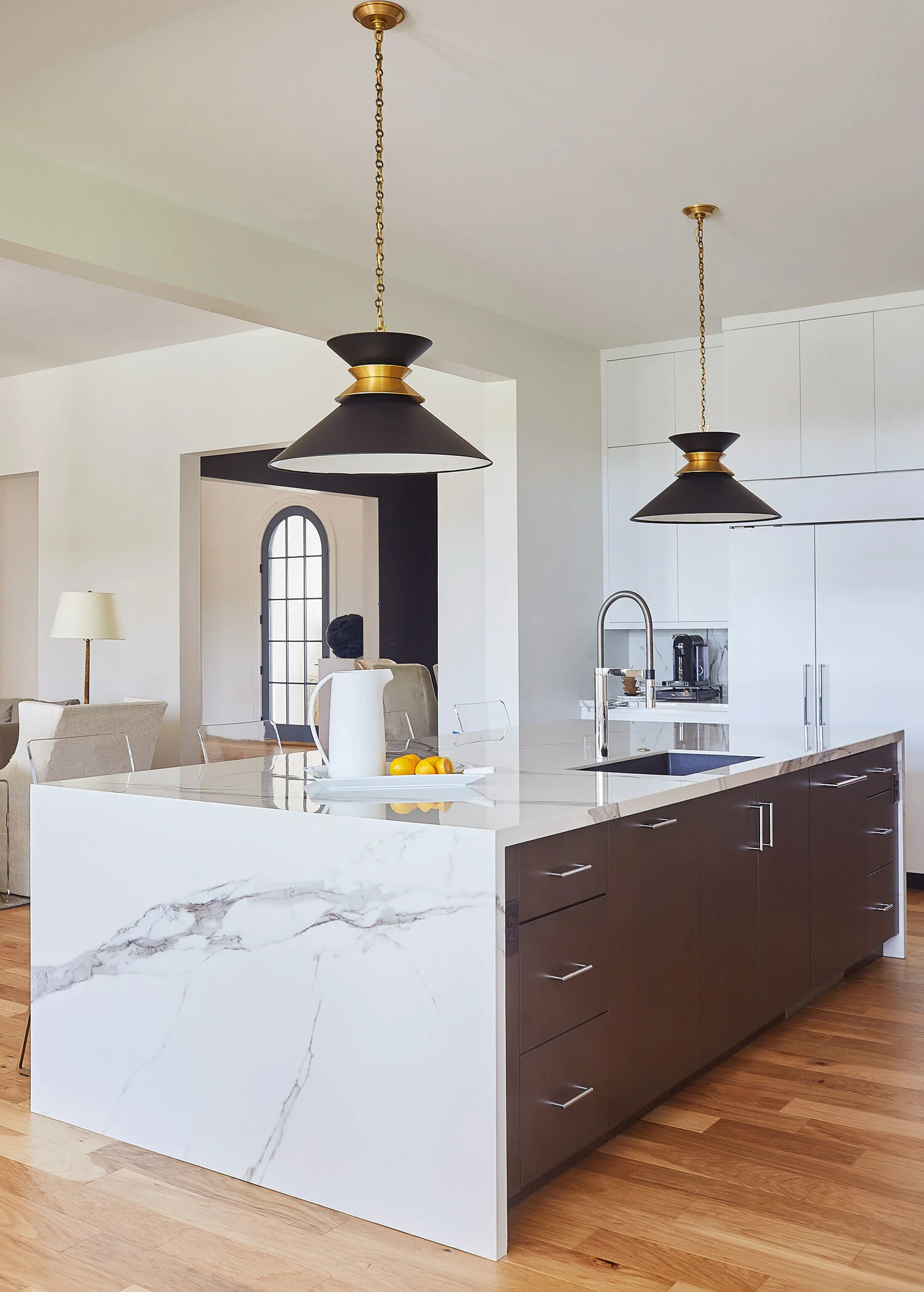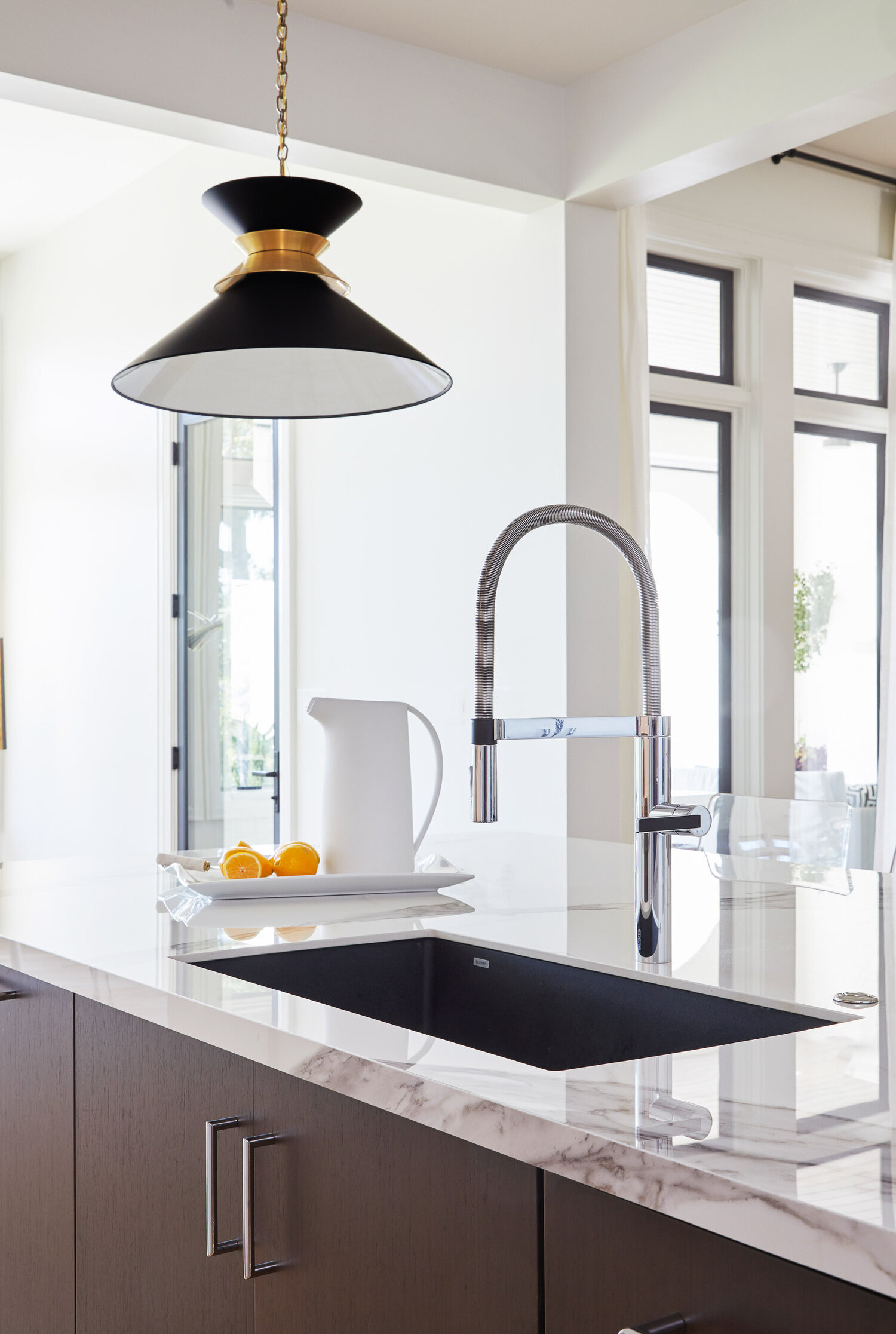The Pros and Cons of Large Format Porcelain
Make A Design Statement With Large Format Porcelain
It's an exciting time for homeowners considering kitchen or bathroom remodeling projects. Today, thanks to modern computer-aided manufacturing techniques, you have more choices at better price points than ever before in terms of materials for your home.
One material that has been rapidly gaining in popularity is large format porcelain. Here at Toulmin, we're definitely seeing this as a growing trend among our clients. Thanks to modern manufacturing techniques, slab porcelain is now available for kitchen and bathroom countertops. Thin-sheet large format porcelain is the perfect material for a kitchen backsplash, shower surround, fireplace surrounds, or even the bathroom floor!
In this post, we're going to look at the pros and cons of large format porcelain slabs, from manufacturing and installation to cleaning and maintenance.
What Is Porcelain Made Of?
Essentially, porcelain is made from natural clay and has been around for thousands of years. China has been producing porcelain for centuries. The primary material used to create it is a clay with a high percentage of a mineral known as kaolinite, often referred to as China clay.
Along with kaolinite, porcelain contains silica, feldspar, and other mineral oxides, which give the material its strength and durability. The clay is put into a kiln and fired at extremely high temperatures. The end result is a super dense material nearly impervious to stains, heat, UV rays, water, scratching, chips, and cracks. Pigmented glazes are added during manufacturing to create different colors and patterns on the porcelain slab.
Porcelain can be either glazed or unglazed. A matte or high-gloss glaze is applied (this glaze can sometimes include a pattern); it's then fired a second time, so the glaze fuses and adheres. This glaze decreases porosity, increases durability, and creates a glossy finish.
The Pros of Large Format Porcelain
Large porcelain slabs have been a popular finish in Europe for a while, but since they've crossed the pond, they're making a big splash here in the US! Traditionally when we think about porcelain tile, what inevitably comes to mind are small squares, or 4x6" (or larger) subway style tiles separated by grout lines.
Suppose you've renovated your home anytime in the last decade. In that case, you might have replaced your ugly tile surfaces with granite or, if you've remodeled more recently, engineered stone like quartz. Today, thanks to computer-aided manufacturing technology, large format porcelain tiles are available that recreate the look of natural material. They have a depth of pattern that is almost identical to natural marble, granite, wood linen, or any other natural material you can think of. Best of all, it comes with none of the maintenance issues or use restrictions of the natural material it emulates.
Large-format porcelain slabs come in two sizes and two thicknesses. Slabs are 118" x69" and 126" x 63". Both are available in 6MM thickness, and the 126" slabs are available in 12MM. It's an excellent durable material that is significantly lighter and less costly than natural stone slabs and tile.
Large-format porcelain is a stunning surface that:
• Requires no maintenance
• Is a hard and durable material
• Is installed with minimal grout; seams are basically imperceptible
• Porcelain slabs are designed for fast installs over existing surfaces, produce less waste, and are less expensive than stone.
• Porcelain is non-porous and etch, stain, and heat resistant
Porcelain slabs work in almost any situation. Countertops to shower surround, backsplashes, bathroom floors, fireplace surround, and anywhere you want a seamless look of continuous material, porcelain slabs are an excellent choice. With a wide range of natural finishes with the depth of natural material patterns, porcelain slabs are an excellent choice. If you want to stay on the cutting edge with your project, large format porcelain is a perfect choice.
The Cons...
Every material, natural or manmade, has drawbacks, and porcelain is no exception! There are some cons to large format porcelain. They include:
• Large format porcelain is challenging to fabricate.
Unlike stone and other materials, porcelain's pattern does not have designs entirely through the materials. Patterns are basically printed onto the top or glazed onto the material. Because of its large size, slabs can be more brittle than other materials like quartz or stone and more prone to chipping.
• Ceramic Knives Can Scratch the Surface
While porcelain slabs are virtually scratch-proof, ceramic knives are its kryptonite! They are the one thing that can scratch porcelain. So the advice is, don't use ceramic knives, and always use a cutting board on any countertop!
As a result of the manufacturing process and the fact that the color is not throughout the entire material, should it chip or become scratched, during transportation or installation, it is difficult to touch it up or repair it. Due to its manufacturing process, it generally gives a low yield due to the extensive veining, making it expensive if you need a large run.
Learn the cost of a bathroom remodel
Installation Options
Like most countertops, when you choose large format porcelain, you have many options to choose from to meet your stylistic and design needs. Depending on the manufacturer, porcelain slabs come in various colors, all derived from natural pigments. You can also choose from a wide range of patterns and looks available, from marble or metallic to rusted steel, wood grain, or several stone species.
You also have a range of finishes to choose from as smooth or textured finishes can be easily achieved during manufacturing. High-gloss, matte or honed finishes are the most popular. While you won't have as many finish options like natural stone, the most popular types are available.
Because of how it's manufactured, porcelain's edges are unique. While you can create most of the standard edges, including round, beveled, straight, bullnose, cove, platner, waterfall, and others, they don't all translate well. Because porcelain's color is "applied," you are limited as to which edge styles work. A fancy edge, with rounded corners, bevels, and grooved, will remove the pattern.
Because of the size of the slabs and the thinness of the sheets, porcelain can sometimes be applied over your existing countertops, sheetrock, tile, or other surfaces. This versatility can reduce costs because you don't necessarily need to pay the cost of removing your old surfaces.
The Bottom Line...
When it comes down to making a choice, ultimately it depends on your aesthetic style, your functional needs, and your budget. If you love being on the cutting edge of design or you're looking for beautiful, unique materials that can make a stunning impact, large format porcelain is an excellent choice.
Large-format porcelain can fit into almost any design and any function within your home, from a feature wall or fireplace surround to creating a seamless look in the master bath shower surround and floor. It's even perfect for some outdoor applications as it's entirely UV resistant.
Porcelain is extremely hard and not prone to etching, staining, or other damage like natural stone. Unlike marble or stone, each porcelain slab is uniform, so you don't need to spend a lot of time visiting stone yards to choose the "perfect" slab. In fact, you can continue a vein across a complete wall or cabinet bank with book-matched slabs for a really upscale look.
The bottom line is that large format porcelain is versatile, flexible, durable, affordable, and incredibly beautiful!
If you live in the West Central Alabama area, and you'd like to learn more about large format porcelain slabs, give the design experts at Toulmin Kitchen & Bath a call at (205) 366-0807. Our design team can help educate you on all of the choices of materials available to you. Let us help you to create your dream kitchen to meet your needs now and into the future! Call today and arrange a free no-obligation consultation to discuss your project.


